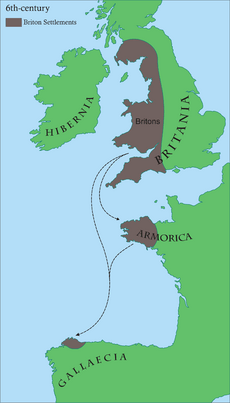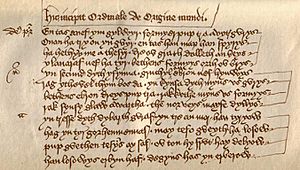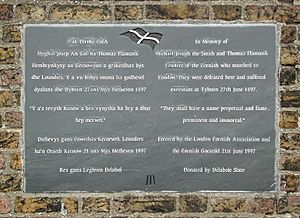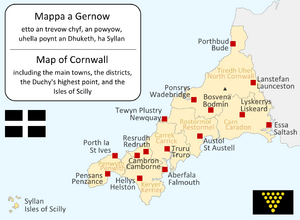Cornish language facts for kids
Quick facts for kids Cornish |
||||
|---|---|---|---|---|
| Kernewek, Kernowek | ||||
| Native to | United Kingdom | |||
| Region | Cornwall | |||
| Ethnicity | Cornish | |||
| Extinct | c. 1777 | |||
| Language family | ||||
| Standard forms | Standard Written Form | |||
| Writing system | Latin alphabet | |||
| Official status | ||||
| Regulated by | Cornish Language Partnership | |||
| Linguist List | cnx Middle Cornish | |||
| oco Old Cornish | ||||
| Linguasphere | 50-ABB-a | |||
|
||||
Cornish (called Kernewek or Kernowek in its own language) is a Celtic language. It is part of the Brittonic group, like Welsh and Breton.
Cornish stopped being spoken as a main language in Cornwall around 1777. But in the early 1900s, people started working to bring it back. This is called a language revival. Today, Cornish is seen as a very important part of Cornish identity and culture. More and more people are learning it as a second language. Some families are even raising their children to speak Cornish from birth! The language is now officially recognised in Europe.
Cornish, Welsh, and Breton all come from an old language called Common Brittonic. This language was spoken across much of Great Britain a long time ago, before English became common. Cornish was the main language in Cornwall for many centuries. It was very similar to Breton, so speakers of both languages could understand each other easily. Cornish was used by many people in Cornwall until the mid-1700s.
The language revival began in the early 20th century. In 2010, UNESCO (a part of the United Nations) said that Cornish was no longer "extinct." Since then, many Cornish textbooks and books have been published. More people are studying the language. You can now find Cornish music, independent films, and children's books. Some children in Cornwall are growing up speaking both Cornish and English. The language is also taught in schools. The first Cornish language nursery (day care) opened in 2010.
Contents
What is Cornish?
Cornish is one of the Brittonic languages. These languages are a branch of the Celtic language family. Other Brittonic languages include Welsh and Breton. There was also a language called Cumbric, but it is now extinct. Other Celtic languages, like Scottish Gaelic, Irish, and Manx, belong to a different branch called Goidelic.
Some experts, like Joseph Loth, thought that Cornish and Breton were so similar they could be seen as two dialects of the same language.
History of Cornish
Cornish developed from Common Brittonic. This was the language spoken in Britain during the British Iron Age and Roman times. Over time, people speaking English moved west across Britain. This separated the Brittonic speakers in the southwest (Cornwall) from those in Wales and Cumbria. The southwestern Brittonic language then became Cornish and Breton. Breton developed because some people moved from Britain to a part of Europe now called Brittany.
Old Cornish (800–1200)
During this time, the area where Cornish was spoken was mostly the same as modern-day Cornwall. The earliest written example of Cornish is from the 9th century. It's a note in a Latin book, using the Cornish words ud rocashaas, which means "it [the mind] hated the gloomy places."
A more important old Cornish text is a Cornish-Latin dictionary called the Vocabularium Cornicum. It has about 940 words, many of which are clearly Cornish. For a long time, people thought this book was in Old Welsh, but in the 18th century, it was correctly identified as Cornish. Back then, Welsh, Cornish, and Breton were very similar.
Middle Cornish (1200–1600)
Cornish was widely spoken during the Middle Cornish period. It reached its peak with about 39,000 speakers in the 13th century. Most of the old Cornish stories and plays that helped bring the language back come from this time. The most famous is the Ordinalia, a series of three plays about the Bible. These plays were written to teach Cornish people about their religion.
In 1542, a writer named Andrew Boorde said that in Cornwall, "many men and women... cannot speak one word of Englysshe, but all Cornyshe." This shows that Cornish was still very strong.
However, in 1549, a law called the Act of Uniformity was passed. It said that church services had to be in English, not Latin. Many people in Cornwall did not understand English. This led to a protest known as the Prayer Book Rebellion. The rebels wanted to keep their old religious services and said they didn't understand the new English ones. The protest was put down, and this event greatly harmed the Cornish language.
Many things caused the language to decline after this. In 1680, William Scawen listed reasons like the lack of a Cornish alphabet, less contact with Brittany, and no Cornish Bible.
Early Modern Cornish (1578–1800)
By the mid-1600s, Cornish was mostly spoken only in the far west of Cornwall. Fewer and fewer children were learning it. In 1602, Richard Carew wrote that most people in Cornwall spoke English, but some still preferred Cornish. If you asked them for directions, they might say, "Meea navidna caw zasawzneck," meaning "I will speak no Saxonage" (no English).
There are fewer writings from this period. In 1776, William Bodinar wrote a letter in Cornish. This was probably the last piece of prose (normal writing) in the language. The last poem was the Cranken Rhyme, written later by John Davey.
Decline of Cornish speakers between 1300 and 1800

Dolly Pentreath (who died in 1777) is often called the last native speaker of Cornish. However, some experts think others might have spoken it after her. It's hard to know for sure because there were no recordings back then. But this interest in finding the last speaker helped set the stage for the language revival.
Here's a table showing how the number of Cornish speakers changed over time:
| Year | Area where Cornish was spoken (in km²) |
Total population of Cornwall |
Number of Cornish speakers |
|---|---|---|---|
| 1050 | 16,000 | 15,000 | |
| 1110 | 21,000 | 20,000 | |
| 1150 | 28,000 | 26,000 | |
| 1200 | 3,270 | 35,000 | 30,000 |
| 1250 | 43,000 | 34,000 | |
| 1300 | 2,780 | 52,000 | 38,000 |
| 1350 | 48,000 | 32,000 | |
| 1400 | 2,360 | 55,000 | 34,000 |
| 1450 | 2,360 | 62,000 | 33,000 |
| 1500 | 1,890 | 69,000 | 33,000 |
| 1550 | 76,000 | 30,000 | |
| 1600 | 1,400 | 84,000 | 22,000 |
| 1650 | 910 | 93,000 | 14,000 |
| 1700 | 530 | 106,000 | 5,000 |
| 1750 | 160 | 140,000 | "Very few" |
| 1800 | 0 | 192,000 | 0 |
Recent Modern Cornish (Revival)
In 1904, Henry Jenner published A Handbook of the Cornish Language. Many people see this book as the start of the modern revival movement.
The revival focused on bringing the language back to life. This included creating new words for modern things and making materials to teach Cornish. Over time, different ways of writing Cornish were developed. This caused some disagreements among speakers. To solve this, a group called the Cornish Language Partnership was formed in 2005. They worked to create a Standard Written Form for Cornish, which was agreed upon in 2008. This standard helps everyone learn and use the language in a consistent way.
Who speaks Cornish today?
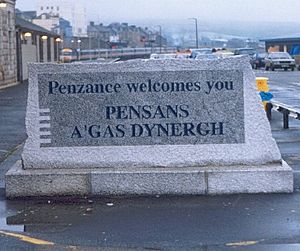
Most Cornish speakers live in Cornwall. Some also live outside Cornwall, especially in places where Cornish people have moved over the years. It's hard to count exactly how many people speak Cornish. But we know the number is growing!
Before the 1980s, there were only about 50 speakers. By the end of the 20th century, this number grew to around 300. In 2008, it was estimated that about 2,000 people could speak Cornish fluently. In 2011, a government survey found that 557 people in England and Wales said Cornish was their main language. About 464 of these lived in Cornwall.
A study in 2018 found that over 3,000 people in Cornwall have at least some Cornish skills. About 500 of these are thought to be fluent. The University of Exeter is working with the Cornish Language Partnership to study this growth.
Official Recognition
Cornish does not have official status like English, but it is recognised in other ways.
International Recognition
In 2002, Cornish was named a regional or minority language under the European Charter for Regional or Minority Languages. This means it gets some protection and support. UNESCO now calls Cornish "critically endangered," which is better than its old label of "extinct."
Within the UK
Cornwall Council supports the language. In 2009, they decided to use Cornish in council publications and on signs where possible. In 2015, they encouraged staff to use basic Cornish words when talking to the public. However, in 2021, a marriage ceremony could not be held entirely in Cornish because of an old law.
In 2014, the UK Government recognised Cornish people as a national minority. This gives them certain rights and protections for their language. In 2016, the UK government stopped funding the Cornish language directly, and this responsibility moved to Cornwall Council.
How Cornish Works
Cornish grammar is different from English in several ways. These features are common in other Celtic languages:
- Initial consonant mutations: The first sound of a Cornish word can change depending on the words around it. For example, 'p' can become 'b' or 'f'.
- Inflected prepositions: Prepositions (like "with" or "by") combine with pronouns (like "me" or "him") to form a single word. For example, gans (with) + my (me) becomes genev.
- No indefinite article: There's no word for "a" or "an." So, Porth can mean "harbour" or "a harbour." There is a word for "the" (an).
- Verb-Subject-Object word order: In English, we say "I eat apples" (Subject-Verb-Object). In Cornish, it's often Verb-Subject-Object.
- Two forms for "to be": Cornish has two different ways to say "to be," depending on the meaning.
Cornish nouns are either masculine or feminine. They don't change based on their role in a sentence (like "he" vs. "him" in English). Cornish has many ways to make words plural.
Some Cornish words are very specific to Cornwall's culture. For example, atal means "mine waste," and beetia means "to mend fishing nets." Foogan and hogan are types of pastry cakes. Troyl is a traditional Cornish dance party, and Furry is a special ceremonial dance.
Cornish Culture
Groups like the Celtic Congress and Celtic League work to protect and promote Celtic languages and cultures, including Cornish.
Some films have been made entirely or mostly in Cornish, like Hwerow Hweg. Some businesses in Cornwall use Cornish names.
The Cornish language has had a big impact on place names and surnames in Cornwall. Knowing Cornish can help you understand what these old names mean. Many people also choose Cornish names for their children, pets, houses, and boats.
There is a growing amount of Cornish literature, including poetry and songs. There are also traditional Cornish chants that were performed at markets and festivals.
You can find magazines written only in Cornish, like An Gannas. BBC Radio Cornwall has a short news broadcast in Cornish every week. Local newspapers sometimes have articles in Cornish too. There's also an online radio service called Radyo an Gernewegva that publishes a weekly podcast with music and interviews in Cornish.
Many organisations support the Cornish language, such as Agan Tavas (Our Language) and Kesva an Taves Kernewek (the Cornish Language Board). There are also traditional ceremonies that use the language.

Cultural Events
Even though the number of Cornish speakers is still small, the language is used in many ways. People speak it at home, at work, and at special events. It's also used in the arts. The modern Cornish language is built on the old historical Cornish, and it continues to grow and change.
Cornwall hosts cultural events related to the language, like the international Celtic Media Festival. The Old Cornwall Society also promotes the use of Cornish at its events. Two ceremonies that use both English and Cornish are Crying the Neck (a harvest festival) and the annual mid-summer bonfires.
Learning and Teaching Cornish
Cornish is taught in some schools. You can also study it at university level, for example, as part of a Cornish Studies course at the University of Exeter. The University of Cambridge also offers Cornish courses.
In 2015, a special course was launched to help adults who work with young children introduce Cornish into nurseries and playgroups. This course helps them use Cornish in a fun way with little ones.
Cornwall's first Cornish language nursery, Skol dy'Sadorn Kernewek, opened in 2010. It teaches children aged two to five, and their parents, to help the language be spoken at home too.
There are many dictionaries and course books available to help people learn Cornish. You can also find classes and conversation groups for adults in Cornwall and in cities like London.
Studying Cornish History
Scholars have studied the Cornish language for centuries. William Scawen (who died in 1689) was one of the first to realise the language was dying. He wrote detailed notes to try and save it. A group of scholars in Mousehole also worked to preserve Cornish. They translated parts of the Bible and wrote proverbs and songs.
Edward Lhuyd, a Welsh language expert, visited Cornwall in 1700 to study the language. He published a study in 1707 that showed how the language had changed over time.
John Whitaker, a historian, studied why Cornish declined. He believed that the English church services forced on the Cornish people in the 1500s greatly hurt the language.
The first full Cornish dictionary was published in 1865 by Robert Williams. Later, more old manuscripts were found, and new words were added to the dictionary.
When Cornish gained new recognition in 2002, there was a big push to agree on a single way of writing the language. This was important for teaching and using Cornish in public life. In 2007, the Cornish Language Partnership helped bring different groups together to create the Standard Written Form. This new form of Cornish was designed to be easy for new learners and good for experienced speakers.
Cornish Literature
There are now many books written in Cornish. In 1981, a 15th-century Cornish poem called Passyon agan arluth was published. The first full translation of the Bible into Cornish was published in 2011.
Small publishers produce books in Cornish, and you can find them in local bookshops and online. The Truro Waterstones bookshop hosts the annual "Holyer an Gof" literary awards. These awards celebrate books about Cornwall or in the Cornish language.
Many famous books have been translated into Cornish, including:
- Alice's Adventures in Wonderland (2009)
- Around the World in Eighty Days (2009)
- Treasure Island (2010)
- The Railway Children (2012)
- The Hound of the Baskervilles (2012)
- The War of the Worlds (2012)
- The Wind in the Willows (2013)
- Three Men in a Boat (2013)
- A Christmas Carol (2012 award winner)
- The Hobbit (translated by Nicholas Williams in 2014)
There are also Cornish books for children, like Ple'ma Spot? (Where's Spot?) and Topsy and Tim titles.
An Gannas is a monthly magazine written entirely in Cornish.
Cornish in Media
In 1983, BBC Radio Cornwall started broadcasting about two minutes of Cornish each week. Later, they had longer programmes and now have a five-minute news bulletin called An Nowodhow ("The News"). There's also an online radio podcast called Radyo an Gernewegva.
Some Cornish television shows have been made, including short lessons and programmes about Cornish culture. In 2016, Kelly's Ice Cream made a TV commercial in Cornish!
The US TV show Deadwood once featured a conversation in Cornish between miners.
Cornish Music
Many traditional Cornish folk songs have been collected and can be sung in Cornish. These include "An Awhesyth" and "Bro Goth agan Tasow" (the Cornish anthem).
In 2018, the singer Gwenno Saunders released an album called Le Kov entirely in Cornish. She said she speaks Cornish with her son and wants to share the language.
Place-names and Surnames
The Cornish language has greatly influenced the names of places and people in Cornwall. Knowing Cornish can help you understand the old meanings of these names. Many people choose Cornish names for their children, pets, houses, and boats.
Here are some examples of Cornish place-names and surnames, and their English versions:
|
|
Samples of Cornish
Here are some examples of Cornish phrases and their English translations:
From the Universal Declaration of Human Rights:
| Cornish | Translation |
|---|---|
| Genys frank ha par yw oll tus an bys | All human beings are born free and |
| yn aga dynita hag yn aga gwiryow. | equal in dignity and rights. They are |
| Enduys yns gans reson ha kowses | endowed with reason and conscience |
| hag y tal dhedha omdhon an eyl orth | and should act towards one another |
| y gila yn spyrys a vrederedh. | in a spirit of brotherhood. |
From Bro Goth agan Tasow, the Cornish anthem:
| Cornish | Translation |
|---|---|
| Bro goth agan tasow, dha fleghes a'th kar, | Old land of our fathers, your children love you, |
| Gwlas ker an howlsedhes, pan vro yw dha bar? | Dear country of the west, what land is your equal? |
| War oll an norvys 'th on ni skollys a-les, | Over all the world, we are spread far and wide, |
| Mes agan kerensa yw dhis. | But our love is for you. |
| Kernow, Kernow y keryn Kernow; | Cornwall, Cornwall, we love Cornwall; |
| An mor hedre vo yn fos dhis a-dro | For as long as the sea is a wall around you |
| Th on onan hag oll rag Kernow! | We are one and all for Cornwall! |
Images for kids
-
Dolly Pentreath (died 1777), often said to be the last person to speak only Cornish, in an engraved portrait from 1781
See also
 In Spanish: Idioma córnico para niños
In Spanish: Idioma córnico para niños


